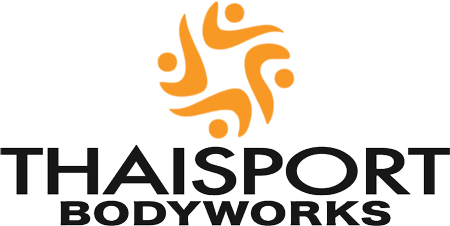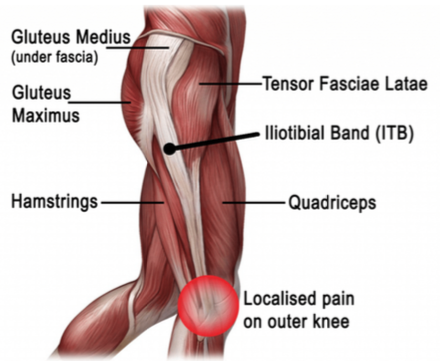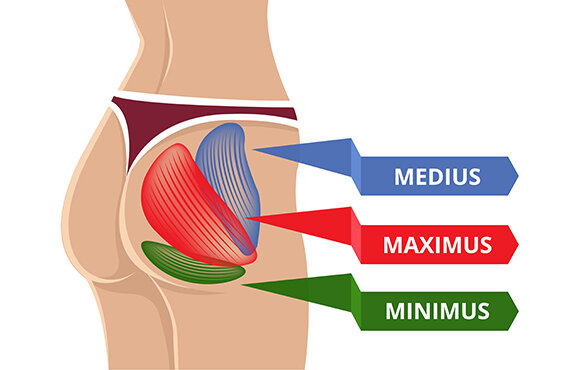The Secret To Resolving IT Band Syndrome
Repetitive Exercise Can Cause Painful IT Bands
If you’ve got a nagging pain on the outer part of your knee, especially if you’re a runner, it could be a symptom of iliotibial band (IT band) syndrome. It’s an injury often caused by activities where you bend your knee repeatedly, like running, cycling, hiking, and walking long distances.
The IT band stands for Ilio-tibial Band and is the longest tendon in the body. It originates out of a hip flexor muscle called TFL (Tensor Fascia Latae) at the Iliac Crest (pelvic bone) and attaches down at the outside of the tibia (shin bone). The ITB is extremely strong (stronger than steel in pound-for-pound tensile strength).
Many people think the ITB is a muscle! All tendons attach to muscles and form myofascial bundles that work together. So it’s not unreasonable to think it’s kind of like a muscle. However, there are a couple of very important differences:
Muscles are more vascular than tendons (supplied with better blood flow), therefore tendons take longer to heal;
Muscles are elastic = stretchy. Tendons are inelastic, meaning that tendons cannot be stretched without being torn, or structurally compromised. The IT Band Syndrome refers to a chronic (long-lasting) sensation of pain felt along the outside of the thigh. Unfortunately, the ITB is a common condition that we often see in our clients, especially in active people who like to hike, run, bike, play tennis, basketball, and other sports.
Pain in the ITB can have several causes. The most typical cause is overloading the hip muscles with “Too Much Too Soon” activity such as a longer-than-usual run or hike, a lengthy car ride or airplane travel, or a new activity that your muscles are just not used to. The response is tension in the hip muscles, resulting in a deep tightness in the IT band, and a painful, sharp or dull, sensation at the outside of the knee.
Does Massage Help?
Absolutely, but usually not because the IT band itself needs to be massaged. In fact, massage on the IT band would be contraindicated during an acute episode of pain. However, massage will help release the hip muscles, thereby creating relief in the ITB itself! The bordering Hamstrings and Quads can be released as well, thereby “ungluing” the ITB from them and allowing the ITB to move freely.
Fortunately, the pattern of the ITB pain is very similar in most cases. Usually, we get a call from a client that goes something like this:
“I have this pain down my IT band. It’s been going on for weeks. I am really disappointed because I have a race (or a ride) coming up next weekend, and I was really hoping it would be resolved by now.”
“How long has it been?” We ask.
“Oh, it’s been 3 or 4 weeks already.” (sometimes longer)
“What have you done to resolve it?”
“I am stretching it every day. Foam-rolling religiously. Not exercising as much.” (this is a typical response)
“Alright, you can stop stretching it,” I usually say. “And you should not foam-roll an inflamed tendon either.”
“Why!?” They sound surprised. “My PT (or trainer) told me to roll it and stretch it.”
“For one, you cannot stretch the IT band,” I explain. “It’s a tendon, therefore it’s inelastic. So by stretching it, you are only tearing at it and possibly causing more damage.”
“What should I do?”
“Let’s book a massage appointment. We’ll work on the surrounding tissues and any tight muscles that might be the cause of it. And we will talk about a plan for faster recovery so you can still run your race.”
I have had this conversation with hundreds of clients. The pattern of pain and tension tends to be very similar, as well as the cause of the ITB pain.
In order to describe the cause, we cannot talk about the ITB without mentioning a pivotal muscle in the health of the hip and knee joints: the Gluteus Medius.
The Pivotal Muscle is the Glute Medius!
The Glute Medius is a pivotal muscle in the most literal sense – our pelvis is capable of pivoting on our femurs thanks to the Glute Medius (among other muscles). Its main job is to stabilize the head of the femur in the hip socket.
The Glute Medius is designed for this complex stability work, however, in modern humans, this muscle has become the culprit of many, if not most, hip and knee related issues, including the ITB Syndrome.
In most people these days, the Glute Medius is too short and too weak.
Too short – because we sit too much. Too weak – because we don’t know it exists – it’s on the lateral side of our body and we cannot see it in the mirror. Most people know about their quads and hip flexors, hamstrings and glutes, but mention Glute Medius and people get a long look and point somewhere around their hip in a vague motion.
When the Glute Medius is too short and too weak, it’s not capable of stabilizing the femur or the pelvis effectively for any length of time. During a run, a ride, or another workout, the Glute Medius fatigues and stops working. Yet, your pelvis must be stabilized. You cannot be wobbly. Therefore, the Glute Medius recruits other muscles to assist it.
The most common muscle that comes to its assistance is the TFL (the muscle of the IT band), since they are right next to each other and share fibers. Because the TFL is not designed for stabilizing the hip (it’s primarily a hip flexor), it promptly tightens up and pulls on its tendon (the ITB). The person feels the tension and pain along the ITB, especially at the lower attachment on the outside of the knee joint.
This is when people try to stretch and roll and massage their IT bands. Does it work? Not really.
The Chain Reaction to IT Band Syndrome
A weak and short Glute Medius will eventually lead to the following:
Instability in the hip and pelvis;
TFL is recruited to help in the stability, but
TFL is quickly overloaded and goes into a spasm, and
Ilio-Tibial Band (TFL’s tendon) is pulled and pulled without relief.
How do we break this chain reaction?
By strengthening the heck out of the Glute Medius.
Once the Glute Medius is strong, it will stop fatiguing during a workout. It will also stop recruiting the TFL, and the pain in the ITB will go away on its own.
This healing recovery should only take 5-7 days of performing a daily exercise that isolates the Glute Medius: Side-Lying Leg Lifts.
Ideally, perform the leg lifts at least once a day: 2 sets of 20 repetitions on each leg. Work up to 2 sets of 30 reps.
Get A Thai Massage
In the meantime, book a Thai Massage with us. Thai Traditional, Thai Sport, or for more in-depth bodywork — Thai Neuromuscular. The Thai Traditional is especially useful for legs and hips. But any of these therapies will be key to relaxing the surrounding tissues, “unglue” the ITB from neighboring Quads and Hamstrings, and release any chronic tension in the TFL, the Glute Medius, and other hip muscles.
Author — Slava Kolpakov



